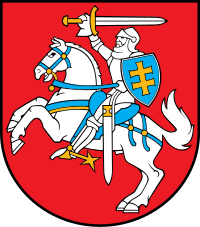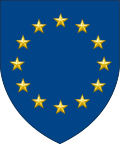Lithuanian Armed Forces
The Lithuanian Armed Forces consist of 20,565 active personnel.[3] Conscription was ended in September 2008[4] but reintroduced in 2015 because of concerns about the geopolitical environment in light of Russia's military intervention in Ukraine.[5]
| Lithuanian Armed Forces | |
|---|---|
| Lietuvos ginkluotosios pajėgos | |
 Insignia of the Lithuanian Armed Forces | |
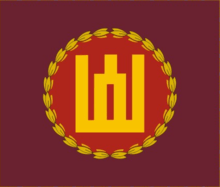 Flag of the Lithuanian Armed Forces | |
| Founded | 23 November 1918 (first Armed Forces about XI-XII c.) |
| Current form | 25 April 1990 |
| Service branches |
|
| Headquarters | Vilnius |
| Leadership | |
| Commander-in-Chief | President Gitanas Nausėda |
| Minister of National Defence | Raimundas Karoblis |
| Chief of Defence | Lieutenant general Valdemaras Rupšys |
| Manpower | |
| Military age | 18–55 |
| Conscription | 9 months |
| Available for military service | 890,074 males, age 16–49 (2016 est.), 875,780 females, age 16–49 (2016 est.) |
| Fit for military service | 669,111 males, age 16–49 (2016 est.), 724,803 females, age 16–49 (2016 est.) |
| Reaching military age annually | 20,425 males (2016 est.), 19,527 females (2016 est.) |
| Active personnel | 19,850 (2018)[1] 14,400 paramilitary (2018)[1] |
| Reserve personnel | 26,000 (2020)[1] |
| Expenditures | |
| Budget | €1.017 billion (2020)[2] |
| Percent of GDP | 2.02% (2020) |
| Industry | |
| Foreign suppliers | |
| Related articles | |
| History | 1918–20 Lithuanian Wars of Independence 1944–45 World War II 1944–53 Lithuanian partisans 1994 Bosnian War 2001–Present 2001 war in Afghanistan 2003–Present Invasion of Iraq 2004–Present Kosovo Force 2013–Present EUTM Mali 2013–Present Operation Atalanta 2014 Operation Sangaris 2015–present EU Navfor Med 2017–present MINUSMA |
| Ranks | Lithuanian military ranks |
Lithuania's defence system is based on the concept of "total and unconditional defence" mandated by Lithuania's National Security Strategy. The goal of Lithuania's defence policy is to prepare their society for general defence and to integrate Lithuania into Western security and defence structures. The defence ministry is responsible for combat forces, search and rescue, and intelligence operations.[6]
The 4,800 border guards fall under the Interior Ministry's supervision and are responsible for border protection, passport and customs duties, and share responsibility with the navy for smuggling / drug trafficking interdiction. A special security department handles VIP protection and communications security.
Conscription
In May 2015 the Lithuanian parliament voted to return the conscription and the conscripts started their training in August 2015.[7] This was after the Crimean Crisis, which heightened international tensions and thus ended the brief respite of seven years when Lithuania abolished its conscription in 2008.[8]
Structure

The Lithuanian Armed Forces consist of the Lithuanian Land Force, Lithuanian Air Force, Lithuanian Naval Force, Lithuanian Special Operations Force and other units: Logistics Command, Training and Doctrine Command, Headquarters Battalion, Military Police. Directly subordinated to the Chief of Defence are the Special Operations Forces and Military Police. The Reserve Forces are under command of the Lithuanian National Defence Volunteer Forces.
Lithuanian Land Force
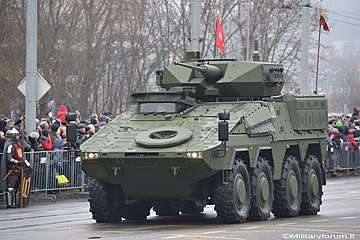
The core of the Lithuanian Land Force structure is the Iron Wolf Mechanised Infantry Brigade (MIB "Iron Wolf") consisting of three mechanized infantry battalions (Grand Duke Kestutis mechanized, Lithuanian Grand Duke Algirdas mechanized and Grand Duke Vaidotas mechanized battalions) and artillery battalion. Other units include King Mindaugas Hussar Battalion, Grand Duchess Birute Uhlan Battalion, Grand Duke Butigeidis Dragoon Battalion, Juozas Vitkus Engineer Battalion and Juozas Luksa Land Force Training Center.
The Lithuanian Land forces are undertaking a major modernization. New weapons and heavier armour are going to be acquired. In 2007 the Land forces bought the German Heckler & Koch G36 rifle to replace the older Swedish Ak-4 as main weapon. There are plans to buy new Infantry fighting vehicles. Lithuania is determined to restructure the armed forces so that from the end of 2014, one tenth of the Land Forces could at any given time be deployed for international operations, while half of the Land Forces would be prepared to be deployed outside Lithuania's borders.
The volunteers have already successfully participated in international operations in the Balkans, Afghanistan and Iraq. The NDVF consists of six territorial units.
Lithuanian Air Force

The Lithuanian Air Force (LAF) is an integral part of the Lithuanian Armed Forces. The LAF is formed from professional military servicemen and non-military personnel. Units are located at various bases across Lithuania:
- Kaunas (Headquarters and the Airspace Surveillance and Control Command);
- Karmėlava (Air Space Control Centre);
- Nemirseta (providing basing for sea search and rescue detachment);
- Šiauliai (LAF Air Base, Air Force Armament and Equipment Repair Depot);
- Radviliškis (Air Defence Battalion).[9]
The initial formation of the LAF was the 2nd transport squadron with the transfer of 20 An-2 aircraft from civilian to military use, with initial basing at the Barushai air base on 27 April 1992. These were joined by four L-39C Albatros aircraft purchased from Kazakhstan as part of the intended 16 to be used by the 1st fighter (training) squadron.
Mil Mi-8 helicopters were modernised by LAF (extended fuel tanks and avionics). In 2008 2 medium-range radars were acquired for the Air Forces Airspace Surveillance and Control Command.
Air space is patrolled by jet fighters from other NATO members, which are based out of the city Šiauliai (Zokniai Airport, known as the Aviation base) (see Baltic Air Policing). The European Union's External border (with Kaliningrad and Belarus) is patrolled by Aviation Unit of the Lithuanian State Border Guard Service which received new helicopters EC-120, EC-135 and EC-145.
Lithuanian Navy
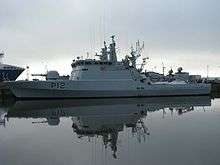
The Navy has over 600 personnel. The Navy consists of the Warship Flotilla, the Sea Coastal Surveillance System, the Explosive Ordnance Disposal (EOD) Divers Team, the Naval Logistic Service, Training Center and Maritime Rescue Coordination Center. The flotilla is the core component of the Navy, and consists of the Mine Countermeasures Squadron, the Patrol Ships Squadron, and the Harbour Boats Group.[10] The current Commander in Chief of the Lithuanian Navy is Rear Admiral Kęstutis Macijauskas. The Naval base and Headquarters are located in the city of Klaipėda.[11] The Navy uses patrol ships for coastal surveillance.
The four newly acquired Flyvefisken class patrol vessels replaced the older Storm class patrol boats and Grisha class corvettes.
Special Operations Force

The Lithuanian Special Operations Force of Lithuanian Armed Forces has been in operation de facto since 2002 and it was established de jure on 3 April 2008, when amendments of National Defence System organisation and military service law came into force.[12] The Special Operations Force is formed from the Special Operations Unit.[13]
The Special Operations Force is responsible for special reconnaissance, direct actions, and military support. It is also in charge of other tasks, e.g., protection of VIPs in peacetime. Its core is based on the Special Purpose Service, Vytautas the Great Jaeger Battalion and Combat Divers Service. Lithuanian Air Force Special Operations Element is subordinate to the Unit at the level of operations management. Its structure is flexible which makes it easy to form squadrons intended for concrete operations and missions from its elements. The Special Operations Force can be called upon inside the territory of Lithuania when law enforcement agencies lack or do not have necessary capabilities to react to terrorist attacks. Capabilities of special forces makes them the main national response force responsible for counter-terrorism operations and operations to prevent violations of sovereignty.[13]
The Special Operations Force Squadron "Aitvaras" was deployed to Afghanistan on the operation "Enduring Freedom". From 2005 to 2006 its squadrons were on standby in NATO Response Force.[13]
International cooperation
Lithuania and NATO
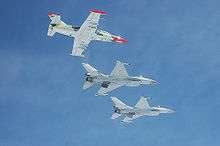
Soon after restoration of independence, Lithuania applied for NATO membership in January 1994. Together with another six Central and Eastern European countries, Lithuania was invited to join the North Atlantic Treaty Organization in the 2002 Prague summit and became a member of the Alliance in March 2004. Lithuania entered NATO on full-fledged rights immediately after the procedures of joining the North Atlantic Treaty were completed and acquired rights to participate in the political decision-making process of the Alliance. Integration into the military structures of NATO became a long-term task of Lithuanian Armed Forces. Mechanised Infantry Brigade "Iron Wolf" was affiliated to the Danish Division on the basis of agreements signed by Denmark and Lithuania in August 2006. Lithuanian Armed Forces started to boost ability of the Brigade to cooperate with the forces of other NATO members. As Lithuania and the other Baltic states do not have capabilities to secure their airspace, fighter jets of NATO members were deployed in Zokniai airport near the city Šiauliai to provide cover for the Baltic states airspace as soon as Lithuania acquired membership in the Alliance.[14]
Lithuania also cooperates with the two other Baltic states – Latvia and Estonia in several trilateral Baltic defence co-operation initiatives:
- Baltic Battalion (BALTBAT) – infantry battalion for participation in international peace support operations, headquartered near Riga, Latvia;
- Baltic Naval Squadron (BALTRON) – naval force with mine countermeasures capabilities, headquartered near Tallinn, Estonia;
- Baltic Air Surveillance Network (BALTNET) – air surveillance information system, headquartered near Kaunas, Lithuania;
- Joint military educational institutions: Baltic Defence College (BALTDEFCOL) in Tartu, Estonia, Baltic Diving Training Centre in Liepāja, Latvia and Baltic Naval Communications Training Centre in Tallinn, Estonia.[15]
In January 2011, the Baltic states were invited to join NORDEFCO, the defence framework of the Nordic countries.[16] In November 2012, the three countries agreed to create a joint military staff in 2013.[17] Future co-operation will include sharing of national infrastructures for training purposes and specialisation of training areas (BALTTRAIN) and collective formation of battalion-sized contingents for use in the NATO rapid-response force.[18]
Foreign missions and operations
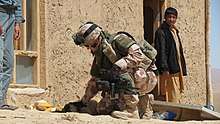
Lithuanian soldiers have taken part in international operations since 1993. Since the summer of 2005 Lithuania has been part of the International Security Assistance Force in Afghanistan (ISAF), leading a Provincial Reconstruction Team (PRT) in the town of Chaghcharan in the province of Ghor. The PRT includes personnel from Denmark, Iceland and US. There have also been special operation forces units in Afghanistan. They were placed in Kandahar province.
Since joining international operations in 1993 Lithuania has lost two soldiers. 1st Lt. Normundas Valteris fell in Bosnia (17 April 1996), Sgt. Arūnas Jarmalavičius in Afghanistan (22 May 2008).[19]
Current operations
| Deployment | Organization | Operation | Personnel[20] |
|---|---|---|---|
| Somalia | EU | Operation Atalanta | 15 |
| Mali | EU | EUTM Mali | 2 |
| Afghanistan | NATO | Operation Resolute Support | 29 |
| Libya | EU | EU Navfor Med | 3 |
| Mali | UN | MINUSMA | 39 |
| Iraq | CJTF | Operation Inherent Resolve | 6 |
| Central African Republic | EU | EUFOR RCA | 1 |
| Kosovo | NATO | KFOR | 1 |
| Ukraine | Training mission | 40 |
List of military equipment
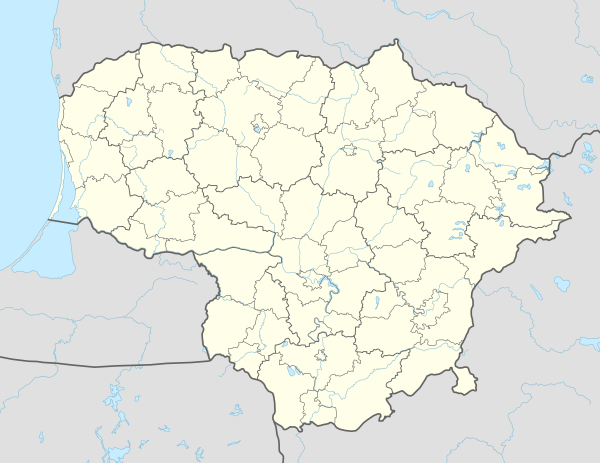
Lithuanian combat forces and headquarters
The unit type is shown by APP-6
Gold – headquarters
Ranks
Citations
- IISS 2019, p. 125.
- https://kam.lt/lt/veikla_576/biudzetas_538.html?c=1
- Personnel size in 1998–2011 Ministry of National Defence
- "Compulsory basic military service discontinued". Ministry of National Defence. Archived from the original on 26 June 2010. Retrieved 9 March 2009.
- "Conscription notices to be sent to 37,000 men in Lithuania".
- "Lietuvos Respublikos krašto apsaugos ministerija :: Titulinis" (PDF). Retrieved 24 December 2014.
- "Värnplikten är tillbaka i Litauen - hård konkurrens om platserna | Utrikes" (in Swedish). svenska.yle.fi. 25 August 2015. Retrieved 3 March 2017.
- "Litauen återinför allmän värnplikt | Utrikes" (in Swedish). svenska.yle.fi. 24 February 2015. Retrieved 3 March 2017.
- "Lithuanian Armed Forces :: Structure " Air Force". Ministry of National Defence, Republic of Lithuania. Archived from the original on 17 October 2014. Retrieved 24 December 2014.
- "Lithuanian Armed Forces :: Structure " Navy". Ministry of National Defence, Republic of Lithuania. Archived from the original on 17 October 2014. Retrieved 24 December 2014.
- "Lithuanian Armed Forces :: Structure " Navy " Command". Ministry of National Defence, Republic of Lithuania. Archived from the original on 17 October 2014. Retrieved 24 December 2014.
- "Ministry of National Defence Republic of Lithuania". Archived from the original on 24 December 2014. Retrieved 24 December 2014.
- "Lithuanian Armed Forces :: Structure " Special Forces". Archived from the original on 8 August 2016. Retrieved 24 December 2014.
- "Ministry of National Defence Republic of Lithuania :: News " News archives " News archive 2009 " News archive (2009–03)". Retrieved 24 December 2014.
- "Baltic Defence Co-operation". Estonian Ministry of Foreign Affairs. January 2002. Archived from the original on 5 August 2011. Retrieved 11 August 2012.
- "Nordic Countries Invite Baltics to Join Defence Co-operation Framework". Estonian Ministry of Foreign Affairs. 21 January 2011. Archived from the original on 8 June 2012. Retrieved 11 August 2012.
- "Joint Baltic Military Staff to Be Established". Estonian Public Broadcasting. 9 November 2012. Archived from the original on 11 November 2012. Retrieved 25 November 2012.
- "Baltic Defence Ministers announced new defence cooperation initiatives". Ministry of National Defence, Republic of Lithuania. 12 December 2011. Retrieved 11 August 2012.
- "Lithuanian Armed Forces :: Multinational operations " In remembrance". Ministry of National Defence, Republic of Lithuania. Retrieved 24 December 2014.
- "LK Gynybos štabas » Vykdomos TO". www.jungtinisstabas.lt.
References
- IISS (2019). The Military Balance 2019. Routledge. ISBN 978-1857439885.
As of this edit, this article uses content from "Lithuanian Armed Forces", authored by Ministry of National Defence Republic of Lithuania, which is licensed in a way that permits reuse under the Creative Commons Attribution-ShareAlike 3.0 Unported License, but not under the GFDL. All relevant terms must be followed.
Further reading
- The Military Strategy of the Republic of Lithuania
- Stefan Marx, 'Lithuania's Defence Structure,' Jane's Intelligence Review, September 1993, p. 407–409
External links
| Wikimedia Commons has media related to Military of Lithuania. |
- Official Ministry of National Defence Republic of Lithuania website
- Official Lithuanian Armed Forces website
- Official Joint Headquarters of Lithuanian Armed Forces website
- Official YouTube channel of Lithuanian Armed Forces
- Official NATO Energy Security Center of Excellence website
- Official General Jonas Žemaitis Military Academy of Lithuania website
